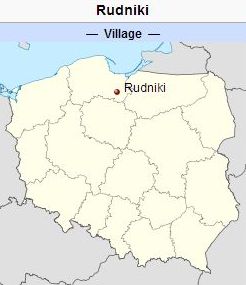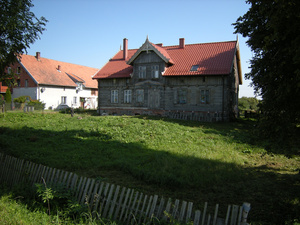Difference between revisions of "Rudnerweide (Pomeranian Voivodeship, Poland)"
| [unchecked revision] | [checked revision] |
GameoAdmin (talk | contribs) (CSV import - 20130820) |
GameoAdmin (talk | contribs) (CSV import - 20130823) |
||
| Line 1: | Line 1: | ||
| − | [[File:Rudniki.jpg|300px|thumb|right|''Rudnerweide (now Rudniki, Poland) | + | [[File:Rudniki.jpg|300px|thumb|right|''Rudnerweide (now Rudniki, Poland) |
| − | Source: [http://en.wikipedia.org/wiki/Rudniki,_Kwidzyn_County Wikipedia Commons] | + | Source: [http://en.wikipedia.org/wiki/Rudniki,_Kwidzyn_County Wikipedia Commons]House in Rudnerweide, built in the 2nd half of the 18th |
| − | century, including a barn from 1753. | + | century, including a barn from 1753. |
| − | Source: [http://holland.org.pl/art.php | + | Source: [http://holland.org.pl/art.php Catalogue of Monuments of Dutch |
| − | Colonization in Poland | + | Colonization in Poland]'']] [[File:Rudnerweide%20house.jpg|300px|thumb|right|''Rudnerweide (now Rudniki, Poland) |
| − | + | Source: [http://en.wikipedia.org/wiki/Rudniki,_Kwidzyn_County Wikipedia Commons]House in Rudnerweide, built in the 2nd half of the 18th | |
| − | + | century, including a barn from 1753. | |
| − | + | Source: [http://holland.org.pl/art.php Catalogue of Monuments of Dutch | |
| − | + | Colonization in Poland]'']] [[File:RudnerweideSchulwiese.jpg|300px|thumb|right|''Detailed map of Rudnerweide, 1913. | |
| − | + | Source: [http://amzpbig.com/maps/2179_Rehhof_1913.jpg Archiwum Map Zachodniej Polski]'']] Rudnerweide (also known in the past as Pascua Rudzińska, Wieś Rudzińska albo pastwisko Benow, Raudnerweide, Rudnerweyde, and Rudnersweide; now known as Rudniki; coordinates: 53.872823, 18.885326 [53° 52′ 22″ N, 18° 53′ 07″ E]; population in 1905, 71, in 1939, 158, in 2012, 120), is a village in the [[Stuhm Lowlands (Pomerania Voivodeship, Poland)|Stuhm Lowlands]] near the Vistula formerly located in [[West Prussia|West Prussia]]. It lies approximately 6 kilometres (4 miles) north-west of Ryjewo (Rehhof), 15 km (9 mi.) north of Kwidzyn ([[Marienwerder (Pomeranian Voivodeship, Poland)|Marienwerder]]), and 59 km (37 mi.) south of the regional capital Gdańsk ([[Danzig, Free City of|Danzig]]). | |
| − | |||
| − | |||
| − | |||
| − | Source: [http://amzpbig.com/maps/2179_Rehhof_1913.jpg Archiwum Map Zachodniej Polski] | ||
| − | |||
| − | '']] Rudnerweide (also known in the past as Pascua Rudzińska, Wieś Rudzińska albo pastwisko Benow, Raudnerweide, Rudnerweyde, and Rudnersweide; now known as Rudniki; coordinates: 53.872823, 18.885326 [53° 52′ 22″ N, 18° 53′ 07″ E]; population in 1905, 71, in 1939, 158, in 2012, 120), is a village in the [[Stuhm Lowlands (Pomerania Voivodeship, Poland)|Stuhm Lowlands]] near the Vistula formerly located in [[West Prussia|West Prussia]]. It lies approximately 6 kilometres (4 miles) north-west of Ryjewo (Rehhof), 15 km (9 mi.) north of Kwidzyn ([[Marienwerder (Pomeranian Voivodeship, Poland)|Marienwerder]]), and 59 km (37 mi.) south of the regional capital Gdańsk ([[Danzig, Free City of|Danzig]]). | ||
Mennonites expelled from the [[Tilsit (Kaliningrad Oblast, Russia)|Tilsit]] marshes, [[East Prussia|East Prussia]], settled here in 1724, draining and reclaiming the swampy area. The family names of these settlers were Arendt, Block, Ediger, Flamming, G(o)ertz, Jantzen, Nickel, Penner, Quiring, Schroeder, Unrau, and Wichert. In the Dutch <em>[[Naamlijst der tegenwoordig in dienst zijnde predikanten der Mennoniten | Mennonites expelled from the [[Tilsit (Kaliningrad Oblast, Russia)|Tilsit]] marshes, [[East Prussia|East Prussia]], settled here in 1724, draining and reclaiming the swampy area. The family names of these settlers were Arendt, Block, Ediger, Flamming, G(o)ertz, Jantzen, Nickel, Penner, Quiring, Schroeder, Unrau, and Wichert. In the Dutch <em>[[Naamlijst der tegenwoordig in dienst zijnde predikanten der Mennoniten | ||
| − | in de Vereenigde Nederlanden|Naamlijst]]</em> the congregation is called "[[Stuhm Lowlands (Pomerania Voivodeship, Poland)|Stuumsche Needering]]op [[Schweingrube (Pomeranian Voivodeship, Poland)|Swijngrube]]." It was later called [[Tragheimerweide (Pomeranian Voivodeship, Poland)|Tragheimerweide]] or [[Zwanzigerweide (Pomeranian Voivodeship, Poland)|Zwanzigerweide]]. It belonged to the [[Frisian Mennonites|Frisian]] branch, also being called [[Waterlanders|Waterlander]]. | + | in de Vereenigde Nederlanden|Naamlijst]]</em> the congregation is called "[[Stuhm Lowlands (Pomerania Voivodeship, Poland)|Stuumsche Needering ]]op [[Schweingrube (Pomeranian Voivodeship, Poland)|Swijngrube]]." It was later called [[Tragheimerweide (Pomeranian Voivodeship, Poland)|Tragheimerweide]] or [[Zwanzigerweide (Pomeranian Voivodeship, Poland)|Zwanzigerweide]]. It belonged to the [[Frisian Mennonites|Frisian]] branch, also being called [[Waterlanders|Waterlander]]. |
The First Partition of [[Poland|Poland]] in 1772 resulted in the creation of a new province in 1773, called [[West Prussia|West Prussia]], in which Rudnerweide was located. Rudnerweide was situated in the district (Kreis) of Stuhm until the end of World War I, when it came under the jurisdiction of the German province of East Prussia. In 1928, Rudnerweide and [[Klein Schardau (Pomeranian Voivodeship, Poland)|Klein Schardau]] were merged into one administrative village named Rudnerweide. Rudnerweide came under the control of Nazi Germany during World War II until February 1945, when it was occupied by Soviet forces and returned to Poland. In 2013 Rudniki was a village in the administrative district of Gmina Ryjewo, within Kwidzyn County, Pomeranian Voivodeship. | The First Partition of [[Poland|Poland]] in 1772 resulted in the creation of a new province in 1773, called [[West Prussia|West Prussia]], in which Rudnerweide was located. Rudnerweide was situated in the district (Kreis) of Stuhm until the end of World War I, when it came under the jurisdiction of the German province of East Prussia. In 1928, Rudnerweide and [[Klein Schardau (Pomeranian Voivodeship, Poland)|Klein Schardau]] were merged into one administrative village named Rudnerweide. Rudnerweide came under the control of Nazi Germany during World War II until February 1945, when it was occupied by Soviet forces and returned to Poland. In 2013 Rudniki was a village in the administrative district of Gmina Ryjewo, within Kwidzyn County, Pomeranian Voivodeship. | ||
Revision as of 14:48, 23 August 2013



Rudnerweide (also known in the past as Pascua Rudzińska, Wieś Rudzińska albo pastwisko Benow, Raudnerweide, Rudnerweyde, and Rudnersweide; now known as Rudniki; coordinates: 53.872823, 18.885326 [53° 52′ 22″ N, 18° 53′ 07″ E]; population in 1905, 71, in 1939, 158, in 2012, 120), is a village in the Stuhm Lowlands near the Vistula formerly located in West Prussia. It lies approximately 6 kilometres (4 miles) north-west of Ryjewo (Rehhof), 15 km (9 mi.) north of Kwidzyn (Marienwerder), and 59 km (37 mi.) south of the regional capital Gdańsk (Danzig).
Mennonites expelled from the Tilsit marshes, East Prussia, settled here in 1724, draining and reclaiming the swampy area. The family names of these settlers were Arendt, Block, Ediger, Flamming, G(o)ertz, Jantzen, Nickel, Penner, Quiring, Schroeder, Unrau, and Wichert. In the Dutch [[Naamlijst der tegenwoordig in dienst zijnde predikanten der Mennoniten in de Vereenigde Nederlanden|Naamlijst]] the congregation is called "Stuumsche Needering op Swijngrube." It was later called Tragheimerweide or Zwanzigerweide. It belonged to the Frisian branch, also being called Waterlander.
The First Partition of Poland in 1772 resulted in the creation of a new province in 1773, called West Prussia, in which Rudnerweide was located. Rudnerweide was situated in the district (Kreis) of Stuhm until the end of World War I, when it came under the jurisdiction of the German province of East Prussia. In 1928, Rudnerweide and Klein Schardau were merged into one administrative village named Rudnerweide. Rudnerweide came under the control of Nazi Germany during World War II until February 1945, when it was occupied by Soviet forces and returned to Poland. In 2013 Rudniki was a village in the administrative district of Gmina Ryjewo, within Kwidzyn County, Pomeranian Voivodeship.
The 1776 Prussian census lists 18 Mennonite families in Rudnerweide with the following surnames: Albrecht, Block, Ediger, Fleming, Goertz, Nickel, Pauls, Penner, Peters, Quiring, Schroeter, Tiart, Unru, and Wichert. In 1885, the settlement counted 14 Catholics, 25 evangelicals and 47 Mennonites.
Mennonites who were residents of Rudnerweide were members of the Tragheimerweide Mennonite Church.
Bibliography
Stowarzyszenie Konserwatorów Zabytków. "Stara Koscielnica." Catalogue of Monuments of Dutch Colonization in Poland. 2005. Web. 6 April 2013. http://holland.org.pl/art.php?kat=obiekt&id=528&lang=en.
Wiebe, Herbert. Das Siedlungswerk niederländischen Mennoniten im Weichseltal. Marburg, 1952: 40, 85.
Wikipedia. "Rudniki, Kwidzyn County." Web. 3 October 2012. http://en.wikipedia.org/wiki/Rudniki,_Kwidzyn_County.
Wolf, Hans-Jürgen. "Familienforschung in Westpreußen." Web. 29 September 2012. http://www.westpreussen.de.
Maps
Map:Rudniki (Pomeranian Voivodeship, Poland)
| Author(s) | Nanne van der Zijpp |
|---|---|
| Richard D. Thiessen | |
| Date Published | April 2013 |
Cite This Article
MLA style
van der Zijpp, Nanne and Richard D. Thiessen. "Rudnerweide (Pomeranian Voivodeship, Poland)." Global Anabaptist Mennonite Encyclopedia Online. April 2013. Web. 16 Apr 2024. https://gameo.org/index.php?title=Rudnerweide_(Pomeranian_Voivodeship,_Poland)&oldid=96315.
APA style
van der Zijpp, Nanne and Richard D. Thiessen. (April 2013). Rudnerweide (Pomeranian Voivodeship, Poland). Global Anabaptist Mennonite Encyclopedia Online. Retrieved 16 April 2024, from https://gameo.org/index.php?title=Rudnerweide_(Pomeranian_Voivodeship,_Poland)&oldid=96315.
Adapted by permission of Herald Press, Harrisonburg, Virginia, from Mennonite Encyclopedia, Vol. 4, p. 375. All rights reserved.
©1996-2024 by the Global Anabaptist Mennonite Encyclopedia Online. All rights reserved.
